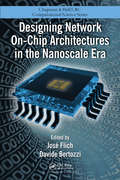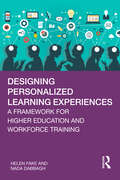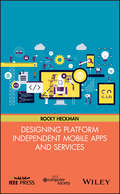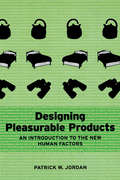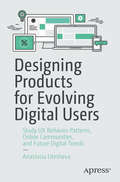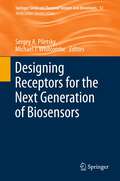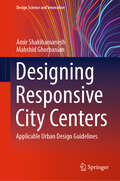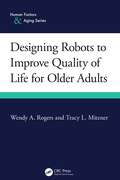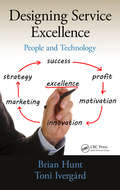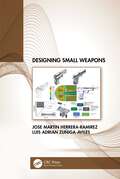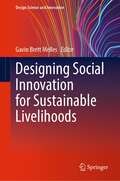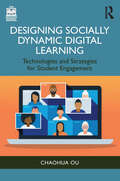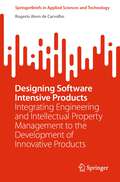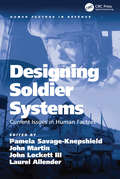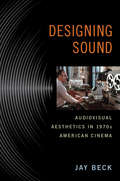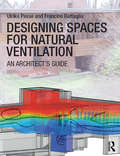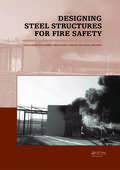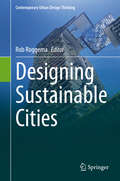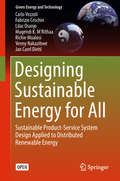- Table View
- List View
Designing Network On-Chip Architectures in the Nanoscale Era
by Davide Bertozzi José FlichGoing beyond isolated research ideas and design experiences, Designing Network On-Chip Architectures in the Nanoscale Era covers the foundations and design methods of network on-chip (NoC) technology. The contributors draw on their own lessons learned to provide strong practical guidance on various design issues.Exploring the design process of the
Designing Personalized Learning Experiences: A Framework for Higher Education and Workforce Training
by Nada Dabbagh Helen FakeDesigning Personalized Learning Experiences offers theoretically grounded and pragmatic approaches to designing personalized learning initiatives for higher education and organizational contexts. With current research concluding that a multitude of variables can enable learners to direct their own experiences and achieve their goals, new guidance is needed to hone the range of instructional approaches, activities, and interactions available to support adult learners. This book offers practical strategies on how to design and implement effective personalized learning interventions, advance learning and engagement, encourage ownership over the learning process, and decrease attrition. Professionals in instructional design, learning and development, organizational development, consultancies, and beyond will be emboldened by the work to leverage a mix of technology-enabled social and content interactions.
Designing Platform Independent Mobile Apps and Services
by Rocky HeckmanPresents strategies to designing platform agnostic mobile apps connected to cloud based services that can handle heavy loads of modern computing. Provides development patterns for platform agnostic app development and technologies. Includes recommended standards and structures for easy adoption. Covers portable and modular back-end architectures to support service agility and rapid development.
Designing Pleasurable Products: An Introduction to the New Human Factors
by Patrick W. JordanMore than ever, designers and technologists are considering human factors in the product design process. Consumers are now seen as key to the overall look and usability of products, not just passive users. Traditional thinking assumed that if a task could be accomplished with a reasonable degree of efficiency and comfort, then the product fit the u
Designing Products for Evolving Digital Users: Study UX Behavior Patterns, Online Communities, and Future Digital Trends
by Anastasia UteshevaDigital user behavior is evolving at an ever-increasing pace, and predicting future trends is a booming business as a result. Users associate technology with their identities now more than ever, and it is up to you as a product designer to enhance their experience for the better. Designing Products for Evolving Digital Users is a 21st century handbook that helps you do just that. By providing insights that allow you to study UX (user experience) behavior patterns, online communities, and future digital trends, Designing Products for Evolving Digital Users instills confidence and fact-based foundations for your digital creations. Author Anastasia Utesheva expertly teaches you how to account for the way the technology impacts the identity of users and how that identity shifts through ongoing interaction with a product or service. She also brings in important case studies on social media, gaming, eRetail, and more to illustrate past examples of technology’s profound impact on communal and individual identity. Digital product design’s ultimate end goal is end user satisfaction. While a myriad of material is available out there consisting of simple tips and tricks for optimal digital design, Designing Products for Evolving Digital Users is a rare and remarkable title that cohesively accounts for all environmental factors involved. Comprehend how distributed technology impacts creation and negotiation of identity and explore communities that form around digital products. UX designers, futurists, students, and industry veterans alike have an abundance of invaluable learning ahead of them in Designing Products for Evolving Digital Users. What You Will LearnLearn how to design digital products/services that resonate with and transform identity of usersStudy how digital impacts formation of identityConsider how digital technology has impacted our world and implications for future digital trendsWho This Book Is For UX designers, digital product creators, entrepreneurs, educators, philosophy of technology enthusiasts, futurists
Designing Reality: How to Survive and Thrive in the Third Digital Revolution
by Neil Gershenfeld Alan Gershenfeld Joel Cutcher-GershenfeldThat's the promise, and peril, of the third digital revolution, where anyone will be able to make (almost) anythingTwo digital revolutions--computing and communication--have radically transformed our economy and lives. A third digital revolution is here: fabrication. Today's 3D printers are only the start of a trend, accelerating exponentially, to turn data into objects: Neil Gershenfeld and his collaborators ultimately aim to create a universal replicator straight out of Star Trek. While digital fabrication promises us self-sufficient cities and the ability to make (almost) anything, it could also lead to massive inequality. The first two digital revolutions caught most of the world flat-footed, thanks to Designing Reality that won't be true this time.
Designing Receptors for the Next Generation of Biosensors
by Michael J. Whitcombe Sergey A. PiletskyDespite achievements in the application of enzymes, antibodies and biological receptors to diagnostics and sensing, the last two decades have also witnessed the emergence of a number of alternative technologies based on synthetic chemistry. This volume shows how synthetic receptors can be designed with characteristics that make them attractive alternatives to biological molecules in the sensory and diagnostics fields, with contributions from leading experts in the area. Subjects covered include synthetic receptors for a range of biomolecules, the use of antimicrobial peptides for the detection of pathogenic microorganisms, the development of molecularly imprinted polymer (MIP) nanoparticles, the in silico design of MIPs and MIP-based sensors, and two chapters examining the development of sensors from an industrial point of view. The particular focus of all chapters is on practical aspects, either in the development process or the applications of the synthesized materials. This book will serve as an important reference work for business leaders and technology experts in the sensors and diagnostics sector.
Designing Renewable Energy Systems within Planetary Boundaries: A Textbook for Energy Engineers (Green Energy and Technology)
by Mika Järvinen Hanna PaulomäkiThis open access book explores interdisciplinary sustainability for energy engineering students. Future generations of engineers need to be game changers. The book is designed to help future engineers redesign the world, avoid harmful lockdowns, and prevent the creation of new problems while transforming energy systems in economically profitable and ecologically sustainable ways. It explains the principles of planetary boundaries, addressing the most relevant ones throughout. The book's focus is on the primary methods for producing renewable power and heating. It discusses the fundamental technical and economic design principles involved. The book also covers key energy storage solutions and includes an overview of the impacts of renewable energy production on ecosystems. The book also serves as a useful guide for engineers working on renewable energy projects.
Designing Responsive City Centers: Applicable Urban Design Guidelines (Design Science and Innovation)
by Amir Shakibamanesh Mahshid GhorbanianThis book explores the history and evolution of city centers and provides practical guidance for designing successful city centers, emphasizing the importance of urban design guidelines in achieving this goal. With a focus on community engagement, environmental quality, and economic benefits, the book offers a roadmap for creating vibrant, dynamic, and sustainable city centers that enhance the overall quality of life for their communities. The book offers guidelines for urban design, which can be used to apply the main principles and solutions related to landscaping, building architecture, and access systems. The guidelines manifest development policies as key solutions and govern the qualitative aspects of the plan, enabling the creation of responsive city centers that benefit their communities. An invaluable resource for anyone interested in urban design and its role in shaping the cities of the future, this book is an essential tool for creating successful and sustainable urban environments.
Designing Robot Behavior in Human-Robot Interactions
by Changliu Liu Te Tang Hsien-Chung Lin Masayoshi TomizukaIn this book, we have set up a unified analytical framework for various human-robot systems, which involve peer-peer interactions (either space-sharing or time-sharing) or hierarchical interactions. A methodology in designing the robot behavior through control, planning, decision and learning is proposed. In particular, the following topics are discussed in-depth: safety during human-robot interactions, efficiency in real-time robot motion planning, imitation of human behaviors from demonstration, dexterity of robots to adapt to different environments and tasks, cooperation among robots and humans with conflict resolution. These methods are applied in various scenarios, such as human-robot collaborative assembly, robot skill learning from human demonstration, interaction between autonomous and human-driven vehicles, etc. Key Features: Proposes a unified framework to model and analyze human-robot interactions under different modes of interactions. Systematically discusses the control, decision and learning algorithms to enable robots to interact safely with humans in a variety of applications. Presents numerous experimental studies with both industrial collaborative robot arms and autonomous vehicles.
Designing Robots to Improve Quality of Life for Older Adults (Human Factors and Aging Series)
by Wendy A. Rogers Tracy L. MitznerWith adults over sixty becoming an ever-increasing proportion of the global population, the challenge of accommodating the needs, preferences, and abilities, of this heterogeneous population has increased. One such method is with robots, which can be used to support everyday activities for older adults and enhance their quality of life. Older adults have been found to be quite open to the idea of interacting with robots, albeit with preferences for the nature of the task they want the robots to do. This book provides a comprehensive state-of-the-art review of the topic of designing robots for older adults.This book translates research on aging, human factors, and human-robot interaction (HRI) into guidance that will be usable for practitioners who design robots for a range of applications. It offers a framework for HRI with a focus on personal characteristics, robot functionality, task demands, and interaction context. The application of this HRI framework for older adults provides the basis for the book. It covers the fundamentals of aging, a review of the different types of robots available now and in the future, the known facilitators and barriers for adoption and the potential of robots for different everyday activities including social engagement, health and wellness, home maintenance and security. Throughout, the authors emphasize the need to follow fundamental human factors processes and participatory design approaches that engage older adults in the design process, thus allowing the reader a thorough and contemporary understanding of robots as an essential future for assisting an aging population.Designing Robots to Improve Quality of Life for Older Adults is intended for a broad professional audience, especially the design community, gerontologists, and human factors/ergonomics practitioners. It will also be suitable for students at the undergraduate and graduate level as a supplementary textbook for courses in human factors, design for aging, and HRI.
Designing Safe Road Systems: A Human Factors Perspective (Human Factors in Road and Rail Transport)
by Jan Theeuwes Richard van HorstMany books focus on individual differences and how those relate to traffic safety such as accident proneness, gender differences, age, alcohol, and the effects of drugs. Others focus on the safety effects regarding the vehicle such as airbags, anti-lock brakes, navigation systems, intelligent cruise control and other new gadgets coming to the vehicle. Even though these topics are undoubtedly important for traffic safety, this book takes a unique approach as it focuses solely on the road environment. Designing Safe Road Systems provides the background for those who want to know more about the effects of road design on driving behaviour. It uses a systems approach to allow a better understanding of why and in what circumstances drivers may commit errors. This understanding will ultimately lead to road systems that prevent (fatal) errors from occurring. The book contains an overview of the current models and theories about human performance and human behaviour in traffic that are relevant for all those involved in designing safe road systems. The central theme of this book is how design principles can reduce the probability of an error while driving. The authors demonstrate how knowledge of human factors helps a road authority to better understand how road users behave. They argue that in many cases the design of the environment can be further adjusted to human capabilities, and that safety should be considered a system property to be built into the road system.
Designing Service Excellence: People and Technology
by Brian Hunt Toni IvergardThe moment of truth-that instant when consumers experience and judge service quality-is often a deciding factor in business success. Designing Service Excellence: People and Technology provides practical information on the design, management, and organization of many different types of service industries, such as hotels, restaurants, banks and fina
Designing Small Weapons
by Jose Martin Herrera-Ramirez Luis Adrian Zuñiga-AvilesThis book focuses on developing small weapons, following the lifecycle of a firearm from design to manufacture. It demonstrates how modern technologies can be used at every stage of the process, such as design methodologies, CAD/CAE/CAM software, rapid prototyping, test benches, materials, heat and surface treatments, and manufacturing processes. Several case studies are presented to provide detailed considerations on developing specific topics. Small weapons are designed to be carried by one person; examples are pistols, revolvers, rifles, carbines, shotguns, and submachine guns. Beginning with a review of the history of weapons from ancient to modern times, this book builds on this by mapping out recent innovations and state-of-the-art technologies that have advanced small weapon design. Presenting a comprehensive guide to computer design tools used by weapon engineers, this book demonstrates the capabilities of modern software at all stages of the process, looking at the computer-aided design, engineering, and manufacturing. It also details the materials used to create small weapons, notably steels, engineering polymers, composites, and emerging materials. Manufacturing processes, both conventional and unconventional, are discussed, for example, casting, powder metallurgy, additive manufacturing, and heat and surface treatments. This book is essential reading to those in the field of weapons, such as designers, workers in research and development, engineering and design students, students at military colleges, sportsmen, hunters, and those interested in firearms. Dr. Jose Martin Herrera-Ramirez is a military engineer with experience in the field of weapon and ammunition development. After receiving his PhD in Materials Science and Engineering from the Paris School of Mines in France, he was the head of the Applied Research Center and Technology Development for the Mexican Military Industry (CIADTIM). He now researches the development of metallic alloys and composites at the Research Center for Advanced Materials (CIMAV) in Chihuahua, Mexico. Dr. Luis Adrian Zuñiga-Aviles is a military engineer with wide experience in the field of weapon and ammunition development. He was head of the prototypes and simulation departments at the Applied Research Center and Technology Development for the Mexican Military Industry (CIADTIM) and head of engineering of the Production directorate. He received his PhD in Science and Technology on Mechatronics from the Center for Engineering and Industrial Development (CIDESI) in Queretaro, Mexico. He now researches the new product design and development for military application, machinery, robotics, and medical devices in the Faculty of Medicine at the Autonomous University of Mexico State (UAEMex) and the Faculty of Engineering at UAEMex as part of the Researchers for Mexico program CONACYT.
Designing Social Innovation for Sustainable Livelihoods (Design Science and Innovation)
by Gavin Brett MellesThis volume discusses how design broadly understood as design of business, policy, product, system, etc. can produce socially responsible innovations with livelihoods consequences. Sustainable Livelihoods Framework (SLF) is a robust framework for analysing and measuring social impact for excluded populations and groups. This is illustrated with case studies from India, Sri Lanka, Bangladesh, Nepal by discussing how initiatives concerned with design in the broad sense have the potential to create sustainable livelihoods. This volume will be of interest to scholars and practitioners in Sustainable Development and Design.
Designing Socially Dynamic Digital Learning: Technologies and Strategies for Student Engagement
by Chaohua OuDesigning Socially Dynamic Digital Learning is a practical guide to the creation of online and blended coursework and learning environments that foster social interaction and engagement among students. Regardless of format, enrollees in higher education need active, collaborative, and social experiences to thrive, though new guidance is needed to help faculty and administrators integrate digital tools and develop courses toward this goal. This book introduces state-of-the-art learning technologies and evidence-based pedagogical strategies that can be seamlessly adopted and adapted across disciplines. Instructors, learning designers, consultants, and educational technology trainers, developers, and directors will find a wealth of fresh insights and best practices as they select, apply, and incentivize digital technologies for social-forward yet outcomes-driven learning experiences.
Designing Software Intensive Products: Integrating Engineering and Intellectual Property Management to the Development of Innovative Products (SpringerBriefs in Applied Sciences and Technology)
by Rogerio Atem de CarvalhoThis book guides the reader through a design process that was tested and optimized in companies and design bureaus. It not only smoothly integrates modern product development techniques, but also addresses, for each phase, issues related to the management of intangible assets. There are several books on the product design process, as well as on the development of innovative products in general. However, none of them addresses how to integrate the engineering techniques with the necessary aspects of Intellectual Property Management. With a focus on software intensive products in general, the book presents a meta-process that adapts to product design in any area where the software element is an important factor in product functionality and innovation.
Designing Soldier Systems: Current Issues in Human Factors (Human Factors in Defence)
by John Martin Pamela Savage-Knepshield John Lockett III Laurel AllenderThis book focuses on contemporary human factors issues within the design of soldier systems and describes how they are currently being investigated and addressed by the U.S. Army to enhance soldier performance and effectiveness. Designing Soldier Systems approaches human factors issues from three main perspectives. In the first section, Chapters 1-5 focus on complexity introduced by technology, its impact on human performance, and how issues are being addressed to reduce cognitive workload. In the second section, Chapters 6-10 concentrate on obstacles imposed by operational and environmental conditions on the battlefield and how they are being mitigated through the use of technology. The third section, Chapters 11-21, is dedicated to system design and evaluation including the tools, techniques and technologies used by researchers who design soldier systems to overcome human physical and cognitive performance limitations as well as the obstacles imposed by environmental and operations conditions that are encountered by soldiers. The book will appeal to an international multidisciplinary audience interested in the design and development of systems for military use, including defense contractors, program management offices, human factors engineers, human system integrators, system engineers, and computer scientists. Relevant programs of study include those in human factors, cognitive science, neuroscience, neuroergonomics, psychology, training and education, and engineering.
Designing Sound: Audiovisual Aesthetics in 1970s American Cinema
by Jay BeckThe late 1960s and 1970s are widely recognized as a golden age for American film, as directors like Francis Ford Coppola, George Lucas, and Martin Scorsese expanded the Hollywood model with aesthetically innovative works. As this groundbreaking new study reveals, those filmmakers were blessed with more than just visionary eyes; Designing Sound focuses on how those filmmakers also had keen ears that enabled them to perceive new possibilities for cinematic sound design. Offering detailed case studies of key films and filmmakers, Jay Beck explores how sound design was central to the era's experimentation with new modes of cinematic storytelling. He demonstrates how sound was key to many directors' signature aesthetics, from the overlapping dialogue that contributes to Robert Altman's naturalism to the wordless interludes at the heart of Terrence Malick's lyricism. Yet the book also examines sound design as a collaborative process, one where certain key directors ceded authority to sound technicians who offered significant creative input. Designing Sound provides readers with a fresh take on a much-studied era in American film, giving a new appreciation of how artistry emerged from a period of rapid industrial and technological change. Filled with rich behind-the-scenes details, the book vividly conveys how sound practices developed by 1970s filmmakers changed the course of American cinema.
Designing Spaces for Natural Ventilation: An Architect's Guide
by Ulrike Passe Francine BattagliaBuildings can breathe naturally, without the use of mechanical systems, if you design the spaces properly. This accessible and thorough guide shows you how in more than 260 color diagrams and photographs illustrating case studies and CFD simulations. You can achieve truly natural ventilation, by considering the building's structure, envelope, energy use, and form, as well as giving the occupants thermal comfort and healthy indoor air. By using scientific and architectural visualization tools included here, you can develop ventilation strategies without an engineering background. Handy sections that summarize the science, explain rules of thumb, and detail the latest research in thermal and fluid dynamics will keep your designs sustainable, energy efficient, and up-to-date.
Designing Steel Structures for Fire Safety
by Jean-Marc Franssen Venkatesh Kodur Raul ZahariaStructural design in fire conditions is conceptually similar to structural design in normal temperature conditions, but often more difficult because of internal forces induced by thermal expansion, strength reduction due to elevated temperatures, much larger deflections, and numerous other factors. Before making any design decisions it is esse
Designing Sustainability for All: The Design of Sustainable Product-Service Systems Applied to Distributed Economies (Lecture Notes in Mechanical Engineering)
by Carlo Vezzoli Cindy Kohtala Brenda Garcia ParraThis open access book introduces design for Sustainable Product-Service Systems (S.PSS) and for Sustainable Distributed Economies (S.DE). These are introduced as technical and operative tools for the development of a new generation of designers, responsible and capable of designing environmentally, socially and economically sustainable solutions, accessible to all. The book provides a comprehensive framework and also practical tools to support the system design for sustainability process. It overviews methodologies, tools and strategies for Sustainable PSS design applied to Distributed Economies (DE) and provides strategies and design guidelines. All of these are highlighted and expanded upon with international case studies.
Designing Sustainable Cities (Contemporary Urban Design Thinking)
by Rob RoggemaThis book emphasizes new ways of designing for a sustainable city and urban environment. From several angles the future of our urbanism is illuminated. From a philosophical point of view, the city is seen as an organism, following complex ecosystemic principles, shining light on indigenous perspectives to become beneficial for sustainable design and core questions are asked whether current architectural practice is really sustainable. Simultaneously concrete practices are presented for cities in transformation, focusing on green infrastructure, smart city principles and health.
Designing Sustainable Energy for All: Sustainable Product-service System Design Applied To Distributed Renewable Energy (Green Energy and Technology)
by Jan Carel Diehl Fabrizio Ceschin Carlo Vezzoli Lilac Osanjo Mugendi K. M’Rithaa Richie Moalosi Venny NakazibweThis open access book addresses the issue of diffusing sustainable energy access inlow- and middle-income contexts.Access to energy is one of the greatest challenges for many people living in low-income and developing contexts, as around 1.4 billion people lack access to electricity.Distributed Renewable Energy systems (DRE) are considered a promising approachto address this challenge and provide energy access to all. However, even if promising,the implementation of DRE systems is not always straightforward.The book analyses, discusses and classifies the promising Sustainable Product-ServiceSystem (S.PSS) business models to deliver Distributed Renewable Energy systems in aneffective, efficient and sustainable way. Its message is supported with cases studies andexamples, discussing the economic, environmental and socioethical benefits as wellas its limitations and barriers to its implementation. An innovative design approach isproposed and a set of design tools are supplied, enabling readers to create and developSustainable Product-Service System (S.PSS) solutions to deliver Distributed RenewableEnergy systems.Practical applications of the book’s design approach and tools by companies andpractitioners are discussed and the book will be of interest to readers in design, industry,governmental institutions, NGOs as well as researchers.
Designing Sustainable Factories: A Toolkit for the Assessment and Mitigation of Impact on the Landscape (Advances in Global Change Research #72)
by Lia MarchiEconomic constraints and lack of knowledge often prevent companies - especially small and medium enterprises - from harmonizing their facilities with the landscape. As a result, factories significantly impact the quality of our living environment, in terms of physical effects on the ecosystem, perceptual interferences with the surroundings, and disturbances on local communities. At both the design and maintenance stages, a set of appropriate tools can assist businesses in becoming more aware of their impacts and identifying possible mitigation strategies. The book presents an assessment tool and a library of inspiring design tactics for factories, with examples of the benefits and synergies for the environment, the scenery, the community, and the company itself. The purpose is to elicit more than a simple reflection about what a sustainable factory entails. It is rather to encourage and assist both businesses and designers in mitigating the impact of industrial facilities on the landscape as holistically as possible.
